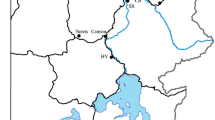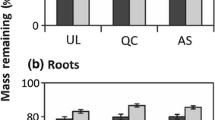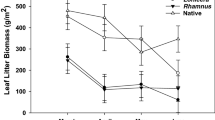Abstract
We investigated the linkages between leaf litter quality and decomposability in a savanna plant community dominated by palatable-spinescent tree species. We measured: (1) leaf litter decomposability across five woody species that differ in leaf chemistry; (2) mass decomposition, nitrogen (N); and carbon (C) dynamics in leaf litter of a staple browse species (Acacia nigrescens) as well as (3) variation in litter composition across six sites that experienced very different histories of attack from large herbivores. All decomposition trials included litter bags filled with chopped straw to control for variation in site effects. We found a positive relationship between litter quality and decomposability, but we also found that Acacia and straw litter mass remaining did not significantly vary between heavily and lightly browsed sites. This is despite the fact that both the quality and composition of litter returned to the soil were significantly different across sites. We observed greater N resorption from senescing Acacia leaves at heavily browsed sites, which in turn contributed to increase the C:N ratio of leaf litter and caused greater litter N immobilization over time. This, together with the significantly lower tree- and herb-leaf litter mass beneath heavily browsed trees, should negatively affect decomposition rates. However, estimated dung and urine N deposition from both browsers and grazers was significantly greater at high- than at low-herbivory sites. We hypothesize that N inputs from dung and urine boost litter N mineralization and decomposition (especially following seasonal rainfall events), and thereby offset the effects of poor leaf litter quality at chronically browsed sites.




Similar content being viewed by others
References
Aber JD, Melillo JM. 1982. Nitrogen immobilization in decaying hardwood leaf litter as a function of initial nitrogen and lignin content. Can J Bot 60:2263–9.
Augustine DJ, McNaughton SJ. 1998. Ungulate effects on the functional species composition of plant communities: herbivore selectivity and plant tolerance. J Wild Manage 62:1165–83.
Augustine DJ, McNaughton J, Frank DA. 2003. Feedbacks between soil nutrients and large herbivores in a managed savanna ecosystem. Ecol Appl 13:1325–37.
Augustine DJ, McNaughton J. 2006. Interactive effects of ungulate herbivores, soil fertility, and variable rainfall on ecosystem processes in a semi-arid savanna. Ecosystems 9:1242–56.
Bardgett RD, Wardle DA. 2003. Herbivore-mediated linkages between aboveground and belowground communities. Ecology 84:2258–68.
Benton JJ. 1991. Kjeldahl method for nitrogen determination. Athens (GA): Micro-Macro Publishing.
Berg B, Matzner E. 1997. The effects of N deposition on the mineralization of C from plant litter humus. Environ Rev 5:1–25.
Bignell DE, Eggleton P. 2000. Termites in ecosystems. In: Abe T, Bignell DE, Higashi M, Eds. Termites: evolution, sociality, symbioses, ecology. Kluwer Academic Publisher. pp 363–87
Bryant JP, Kuropat PJ, Cooper SM, Frisby K, Owen-Smith N. 1989. Resource availability hypothesis of plant antiherbivore defence tested in a South African savanna ecosystem. Nature 340:227–9.
Bryant JP, Provenza FD, Pastor J, Reichardt PB, Clausen T, du Toit J. 1991. Interactions between woody plants and browsing mammals mediated by secondary metabolites. Annu Rev Ecol Syst 22:431–46.
Coates Palgrave K, Coates Palgrave M, Drummond RB, Moll EJ. 2002. Trees of Southern Africa, 3rd edn. Struik Publishers. p 1212
Cooper SM, Owen-Smith N. 1986. Effects of plant spinescence on large mammalian herbivores. Oecologia 68:446–55.
Cooper SM, Owen-Smith N, Bryant JP. 1988. Foliage acceptability to browsing ruminants in relation to seasonal changes in the leaf chemistry of woody plants in a South African savanna. Oecologia 75:336–42.
de Mazancourt C, Loreau M, Abbadie L. 1999. Grazing optimization and nutrient cycling: potential impact of large herbivores in a savanna system. Ecol Appl 9:784–97.
du Toit JT, Owen-Smith N. 1989. Body size, population metabolism, and habitat specialization among large African herbivores. Am Nat 133:736–40.
du Toit J, Bryant JP, Frisby K. 1990. Regrowth and palatability of Acacia shoots following pruning by African savanna browsers. Ecology 71:140–54.
du Toit J. 2003. Large herbivores and savanna heterogeneity. In: du Toit J, Rogers K, Biggs H, Eds. The Kruger experience. Ecology and management of savanna heterogeneity. Washington (DC): Island Press. pp 292–309.
Edwards PB. 1991. Seasonal variation in the dung of African grazing mammals, and its consequences for coprophagous insects. Funct Ecol 5:617–28.
Fornara DA, du Toit JT. 2007. Browsing lawns? Responses of Acacia nigrescens to ungulate browsing in an African savanna. Ecology 88:200–9.
Fornara DA, du Toit J. 2007. Community-level interactions between ungulate browsers and woody plants in an African savanna dominated by palatable-spinescent Acacia trees. J Arid Environ doi:10.1016/j.jaridenv.2007.07.010
Frank DA, Inouye R, Huntly N, Minshall G, Anderson J. 1994. The biogeochemistry of a north-temperate grassland with native ungulates: nitrogen dynamics in Yellowstone National Park. Biogeochemistry 26:163–88.
Gallardo A, Merino J. 1993. Leaf decomposition in two Mediterranean ecosystems of southern Spain: influence of substrate quality. Ecology 74:152–61.
Garibaldi LA, Semmartin M, Chaneton EJ. 2007. Grazing-induced changes in plant composition affect litter quality and nutrient cycling in flooding Pampa grasslands. Oecologia 151:650–62.
Gowda JH. 1996. Spines of Acacia tortilis: what do they defend and how? Oikos 77:279–84.
Grime JP, Cornelissen JHC, Thompson K, Hodgson JC. 1996. Evidence of a causal connection between anti-herbivore defense and the decomposition rate of leaves. Oikos 77:489–94.
Hamilton EW, Frank DA. 2001. Can plant stimulate soil microbes and their own nutrient supply? Evidence from a grazing tolerant grass. Ecology 82:2397–402.
Hobbie SE. 2005. Contrasting effects of substrate and fertilizer nitrogen on the early stages of litter decomposition. Ecosystems 8:644–56.
Hobbs TN. 1996. Modification of ecosystem by ungulates. J Wild Manage 60:695–713.
Högberg P. 1992. Root symbioses of trees in African dry tropical forests. J Veg Sci 3:393–400.
Holdo RM. 2003. Woody plant damage by African elephants in relation to leaf nutrients in western Zimbabwe. J Trop Ecol 19:189–96.
Kielland K, Bryant JP, Ruess RW. 1997. Moose herbivory and carbon turnover of early successional stands in interior Alaska. Oikos 80:25–30.
McNaughton SJ. 1984. Grazing lawns: animals in herds, plant form, and coevolution. Am Nat 124:863–86.
McNaughton SJ, Banyikwa FF, McNaughton MM. 1997. Promotion of the cycling of diet-enhancing nutrients by African grazers. Science 278:1798–800.
Millard P, Hester A, Wendler R, Baillie G. 2001. Interspecific defoliation responses of trees on sites of winter nitrogen storage. Funct Ecol 15:535–43.
Naiman PJ, Melillo JM, Hobbie JE. 1986. Ecosystem alteration of boreal forest streams by beaver (Castor canadensis). Ecology 67:1254–69.
Owen-Smith N. 1990. Demography of a large herbivore, the greater kudu Tragelaphus strepsiceros, in relation to rainfall. J Anim Ecol 59:893–913.
Owen-Smith N, Cooper SM. 1987. Palatability of woody plants to browsing ruminants in a South African savanna. Ecology 68:319–31.
Pastor J, Naiman RJ, Dewey B, McInnes P. 1988. Moose, microbes, and the boreal forest. Bioscence 38:770–7.
Pastor J, Naiman RJ. 1992. Selective foraging and ecosystem processes in boreal forests. Am Nat 139:690–705.
Pastor J, Dewey B, Naiman RJ, McInnes PF, Cohen Y. 1993. Moose browsing and soil fertility in the boreal forests of Isle Royale National Park. Ecology 74:467–80.
Persson I-L, Pastor J, Danell K, Bergström R. 2005. Impact of moose population density on the production and composition of litter in boreal forests. Oikos 108:297–306.
Redfern JV, Grant R, Biggs H, Getz WM. 2003. Surface-water constraints on herbivore foraging in the Kruger National Park, South Africa. Ecology 84:2092–107.
Romero LM, Smith III TJ, Fourqurean JW. 2005. Changes in mass and nutrient content of wood during decomposition in a south Florida mangrove forest. J Ecol 93:618–31.
Ruess RW, McNaughton SJ. 1988. Ammonia volatilization and the effects of large grazing mammals on nutrient loss from East African grasslands. Oecologia 77:382–6.
Scholes RJ, Bond W, Eckhardt H. 2003. Vegetation dynamics in the Kruger ecosystem. In: du Toit J, Rogers K, Biggs H, Eds. The Kruger experience. Ecology and management of savanna heterogeneity. Washington (DC): Island Press. pp 242–62.
Stark S, Julkunen-Tiitto R, Kumpula J. 2007. Ecological role of reindeer summer browsing in the mountain birch (Betula pubescens ssp. czerepanovii) forests: effects on plant defense, litter decomposition, and soil nutrient cycling. Oecologia 151:486–98.
Tracy BF, Frank DA. 1998. Herbivore influence on soil microbial biomass and N mineralization in a northern grassland ecosystem: Yellowstone National Park. Oecologia 114:556–62.
van Grinsven M, Parkipuny ML, Johns T. 1999. Euclea divinorum (Ebenaceae) bark is a high-potential tanning material. Econ Bot 53:220–1.
Venter FJ, Scholes RJ, Eckhardt HC. 2003. The abiotic template and its associated vegetation pattern. In: du Toit J, Rogers K, Biggs H, Eds. The Kruger experience. Ecology and management of savanna heterogeneity. Washington (DC): Island Press. pp 83–129.
Wardle DA, Bonner KI, Barker GM. 2002. Linkages between plant litter decomposition, litter quality, and vegetation responses to herbivores. Funct Ecol 16:585–95.
Wieder RK, Lang GE. 1982. A critique of the analytical methods used in examining decomposition data obtained from litter bags. Ecology 63:1636–42.
Acknowledgments
We thank A. Hester, R. Bardgett, C. Skarpe and S. Hobbie for comments and discussion. Two very knowledgeable reviewers greatly contributed to improve the manuscript. This research was funded through a grant from the National Research Foundation to Johan du Toit (GUN 2053601). The Kruger National Park provided data on rainfall and fire regimes, as well as logistic support during the entire duration of the project.
Author information
Authors and Affiliations
Corresponding author
Electronic supplementary material
Below are the electronic supplementary materials
Rights and permissions
About this article
Cite this article
Fornara, D.A., Du Toit, J.T. Browsing-induced Effects on Leaf Litter Quality and Decomposition in a Southern African Savanna. Ecosystems 11, 238–249 (2008). https://doi.org/10.1007/s10021-007-9119-7
Received:
Revised:
Accepted:
Published:
Issue Date:
DOI: https://doi.org/10.1007/s10021-007-9119-7




